When shopping for kitchen cabinets, there are five things that you should know. They will help you choose the right ones for your home. Cabinets are one of the largest investments in your home, and you want to ensure you get a return on investment. There are many options to consider.
Material
One of the most critical considerations when upgrading your house is selecting the right material for your kitchen cabinets. You want to be sure that the cabinets you pick are sturdy and stylish. As with any other major building project, it’s important to do your research before you make a final decision. It would help to consider how long you plan to live in your house, your lifestyle, and your budget before you decide on the material for your kitchen cabinets. The most popular kitchen cabinet material for many homeowners is medium-density fiberboard (MDF). It’s a manufactured wood product made of small wooden fibers bound together with resin and compressed into panels. It’s a strong and durable material resistant to warping and moisture damage.
Style
The style used in kitchen cabinets Seattle is important when designing a new kitchen. It determines the overall aesthetic of the space and helps you decide what colors or finishes will work best.
Traditional: Inspired by the European golden age, classic cabinetry features intricately carved details and rich woods. It often has raised panels and arched doors.
Transitional: A versatile style, transitional cabinetry combines traditional and contemporary looks. It may be constructed from a variety of materials, including salvaged wood.
Contemporary: Modern kitchen cabinets are known for their minimalist appearance and may be built of various materials with elegant hardware.
Rustic Country:
- This cabinetry
- Emphasizing the natural features of wood
- Maybe the ideal complement to rustic cottage vacations and luxury mountain chalets
It can be made from reclaimed or natural woods and feature a distressed or painted finish.
Finish
The finish you pick for your kitchen cabinets may alter how they appear, protect the wood from moisture and stains, and keep them looking good. The most common options are paint, glaze, and lacquer. A painted cabinet may conceal flaws, highlight the wood grain, and make your kitchen seem more polished and sophisticated. Sage green kitchen cabinets are perfect if you want a modern look with a touch of vintage charm in your kitchen. Painted cabinets, however, are more prone to chipping and revealing signs of wear, especially in high-traffic areas. Glazed finishes add depth to your cabinets and interest while protecting them from moisture and stains. These finishes require more work and maintenance, though. They can be brushed, sanded, and rubbed for different effects, including a distressed or aged appearance.
Functionality
Kitchen cabinets are functional objects that store various kitchen items, from spices and other food items to utensils. They also help keep a kitchen organized and tidy. Optimum placement and accessibility for storing food, tools or other necessary items is key to maximizing efficiency within a kitchen’s workflow. Cabinets should be arranged according to how they’ll be used and the proximity of different work zones. Lower cabinet drawers and trays provide access from above while reducing the pain or crouching associated with standard face-frame design. When the doors and hinges are open, they obstruct a portion of the internal cabinet width, making drawers and trays much smaller than their face-frame equivalents.
Warranty
You will want to choose cabinets that offer a warranty to cover any defects that may occur in the cabinetry. A warranty is an agreement between the manufacturer and the purchaser that guarantees the quality of the cabinets to be free from defects in material and artistry under normal use. The cabinets are usually only guaranteed to last for a while. It is because aging and deterioration are natural occurrences that will affect the longevity of your kitchen cabinets. For example, wood is naturally prone to cracking as it ages. It will also have subtle changes in color and texture due to sunlight, smoke, household cleaners, and other environmental conditions.


